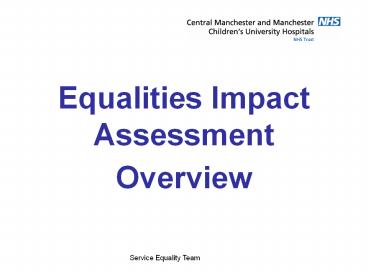Equalities Impact Assessment - PowerPoint PPT Presentation
1 / 16
Title: Equalities Impact Assessment
1
Equalities ImpactAssessment
- Overview
2
What is an Equalities Impact Assessment?
- An Equalities Impact Assessment (EqIA) is a
systematic analysis of the effect or impact that
an existing or proposed policy, service or
function has on the promotion of equality.
3
Aims
- The aim of EqIA process is to identify any
positive - or negative impact on the promotion of equality
- and the Trusts equality groups.
- Age
- Disability
- Gender/Sex
- Race/Ethnicity
- Religion/Belief
- Sexuality
4
EqIA stages
- There are three stages whilst carrying out an
Equality Impact Assessment - Initial this process is a screening stage used
to determine whether a policy or the operation of
a service or function is relevant to the
promotion of equality. - Partial this process is used to assess the
likely impact a draft policy or proposed new
service or function has on the promotion of
equality. - Full this process is used to assess the actual
impact an existing policy, service or function
has on the promotion of equality.
5
Initial
Identify Function/Policy
Assess Relevance
Determine Priority
SET Approval
Sign off
Publish Initial EqIA
6
Partial
Prepare for Partial EqIA
Register Partial EqIA
Gather Information Consult Stakeholders
Assess Likely Impact
Develop Draft EqIA
Submit Draft EqIA to SET
No agreement on draft EqIA
Set Approve Draft EqIA
Sign off EqIA
Amended Proposal (if necessary)
Publish EqIA
Monitor
7
Full
Prepare for Full EqIA
Register Full EqIA
Gather Written Information
Consult Stakeholders
Potential Adverse Impact found after assessment
No potential Adverse Impact found
Assess Actual Impact
Potential or Actual Adverse Impact
Develop Draft Action Plan
Inform SET
Develop Draft EqIA
Publish Draft EqIA
Consult Stakeholders on Draft EqIA
No agreement on Draft EqIA
Sign off EqIA
Publish EqIA
Monitor
8
The Outcomes
- After the completion of the EqIA process you
should have - A clear assessment of whether the policy, service
or function, has a possible or actual impact upon
the promotion of equality - A clear understanding whether there is an adverse
impact upon the overall promotion of equality or
the any of the Trusts Equality Target Groups
9
The Outcomes
- In the case of draft policies and proposed new
services or functions an opportunity to remove
any likely adverse impact or unlawful
discrimination before the policy service or
function is introduced - In the case of existing policies, services or
functions, an action plan for removing any
adverse impact, and also a framework for
monitoring any possible further negative impact
10
Why Undertake an Equalities Impact Assessment?
- An EqIA needs to be undertaken for a number
- of reasons
- Need to understand how inequality can be promoted
through policy, function or service - To ensure the management of equality and
diversity is effective - To make sure equality and diversity is monitored
and evaluated - The Law requires public authorities to carry out
EqIAs
11
When to Undertake an Equalities Impact
Assessment?
- When an EqIA should be conducted depends on what
is being impact assessed.
Using the Different Types of EqIA Processes Using the Different Types of EqIA Processes Using the Different Types of EqIA Processes Using the Different Types of EqIA Processes
Initial Partial Full
Proposed (Draft) Policies ? ?
New Services ? ?
New Functions ? ?
Existing Policies ? ?
Existing Services ? ?
Existing Functions ? ?
12
Who Should Undertake an Equalities Impact
Assessment?
Who Should Conduct an EqIA? Who Should Conduct an EqIA? Who Should Conduct an EqIA? Who Should Conduct an EqIA?
Policy author Service Manager EqIA Team
Proposed (Draft) Policy ?
New Service or Function ?
Existing Policy, Service or Function ?
13
Publishing an Equalities Impact Assessment
- All EqIAs will be published regardless of
- what type of EqIA it is once it has been
- completed and signed.
- This is to ensure
- Openness and transparency
- Accountability
- Compliant with the law
14
The Law and Equalities Impact Assessment
- There is a statutory framework governing EqIAs.
This means that conducting an EqIA is a legal
process. - Most public authorities have a duty to promote
equality in the areas of - Race
- Disability
- Gender
15
The Law and Equalities Impact Assessment
- The Trusts Equality and Diversity Framework
Action for Equality requires that EqIAs should
be undertaken in the additional areas of age,
religion and belief, and sexuality. - The law requires that EqIAs (related to race,
disability and gender) are published.
16
The Law and Equalities Impact Assessment
- The CEHR may issue a Compliance Notice against a
public authority that is not fulfilling any part
of, or all of the duty to promote equality. This
includes not completing EqIAs, or not completing
them correctly. Failing to comply with a
Compliance Notice can lead to legal proceedings
against the public authority.































